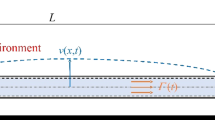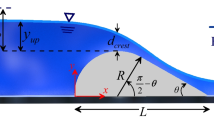Abstract
A further development of exclusively inverse frequency domain method for leak detection in pipelines is presented and validated. The location and leakage can be determined by analyzing the difference of transient water head response between the simulated and measured data in frequency domain. The transient signals are generated by portion sharp closure of a valve from the small constant opening and it needs only a few meters of water. The discrete boundary conditions and observation data are both transformed in frequency domain by Laplace transform. Example in numerical simulation is studied for demonstration of this approach. The application of the method to an experimental pipeline confirms the analysis and illustrates successful detection of the single pipeline leak. The precalibration approach is presented to minimize the effect of data and model error and it splits the method into two parts. One uses data from a known state to fit the parameters of the model and the other uses data from the current state for the fitting of leak parameters using the now calibrated model. Some important practical parameters such as wave speed, friction in steady and unsteady state and the adaptability of the method are discussed. It was found that the nonlinearity errors associated with valve boundary condition could be prevented by consideration of the induced flow perturbation curve shape.
Similar content being viewed by others
References
Liou C. Mass imbalance error of waterhammer equations and leak detection. J Fluid Eng-T ASME, 1994, 116(1): 103–108
Brunone B. Transient test-based technique for leak detection in outfall pipes. J Water Res PL-ASCE, 1999, 125(5): 302–306
Misiunas D, Vítkovský J, Olsson G., et al. Pipeline break detection using pressure transient monitoring. J Water Res PL-ASCE, 2005, 131(4): 316–325
Zhang S Q, Jin S J, Yang F L, et al. Crucial technologies of oil-transporting pipe leak detection and location based on wavelet and chaos. Meas Sci Technol, 2006, 17(3): 572–577
Wang X J, Lambert M, Simpson A, et al. Leak detection in pipelines using the damping of fluid transient. J Hydraul Eng-ASCE, 2002, 128(7): 697–711
Ghazali M, Staszewski W, Shucksmith J, et al. Instantaneous phase and frequency for the detection of leaks and features in a pipeline system. Struc Health Monit, 2011, 10(4): 351–360
Ferrante M, Brunone B. Pipe system diagnosis and leak detection by unsteady-state tests 2: Wavelet analysis. Adv Water Resour, 2003, 26: 107–116
Liou C. Pipeline leak detection by impulse response extraction. J Fluid Eng, 1998, 120(4): 833–838
Beck S, Curren M, Sims N, et al. Pipeline network features and leak detection by cross-correlation analysis of reflected waves. J Hydraul Eng-ASCE, 2005, 131(8): 715–723
Feng J, Zhang H G. Algorithm of pipeline leak detection based on discrete incremental clustering method. Lecture Notes in Artificial Intelligence, 2006, 4114: 602–607
Liggett J, Chen L. Inverse transient analysis in pipe networks. J Hydraul Eng-ASCE, 1994, 120(8): 934–955
Kapelan Z, Savic D, Walters G. A hybrid inverse transient model for leakage detection and roughness calibration in pipe networks. J Hydraul Res, 2003, 41(5): 481–492
Vítkovský J, Lambert M, Simpson A, et al. Experimental observation and analysis of inverse transients for pipeline leak detection. J Water Res PL-ASCE, 2007, 133(6): 519–530
Nash G, Karney B. Efficient inverse transient analysis in series pipe systems. J Hydraul Eng-ASCE, 1999, 125(7): 761–764
Vítkovský J, Simpson A, Lambert M. Leak detection and calibration using transients and genetic algorithms. J Water Res PL-ASCE, 2000, 126(4): 262–265
Sang Hyun Kim. Extensive development of leak detection algorithm by impulse response method. J Hydraul Eng-ASCE, 2005, 131(3): 201–208
Mpesha W, Gassman S, Chaudhry M. Leak detection in pipes by frequency response method. J Hydraul Eng-ASCE, 2001, 127(2): 134–147
Mpesha W, Chaudhry M, Gassman S. Leak detection in pipes by frequency response method using a step excitation. J Hydraul Res, 2002, 40(1): 55–62
Ferrante M, Brunone B. Pipe system diagnosis and leak detection by unsteady-state tests 1: Harmonic analysis. Adv Water Resour, 2003, 26: 95–105
Covas D, Ramos H, Almeida B. Standing wave difference method for leak detection in pipeline systems. J Hydraul Eng-ASCE, 2005, 131(12): 1106–1115
Lee P, Vítkovský J, Lamber M, et al. Leak location using the pattern of the frequency response diagram in pipelines: a numerical study. J Sound Vibration, 2005, 284(3): 1051–1073
Lee P, Lamber M, Simpson A, et al. Experimental verification of the frequency response method for pipeline leak detection. J Hydraul Res, 2007, 44(5), 693–707
Vítkovský J, Lee P, Zecchin A, et al. Head- and flow-based formulations for frequency domain analysis of fluid transients in arbitrary pipe networks. J Hydraul Eng-ASCE, 2011, 137(5): 556–568
Guo X L, Yang K L. Leak detection in pipelines based on hydraulic transient and genetic algorithm analysis (in Chinese). Chin J Comput Mech, 2009, 26(5): 664–669
Nixon W, Ghidaoui M. Numerical sensitivity study of unsteady friction in simple systems with external flows. J Hydraul Eng-ASCE, 2007, 133(7): 736–749
Bergant A, Simpson A, Vítkovský J. Developments in unsteady pipe flow friction modeling. J Hydraul Res, 2001, 39(3): 249–257
Zhang Y, Li B W. Noise reduction method for nonlinear signal based on maximum variance unfolding and its application to fault diagnosis. Sci China Tech Sci, 2010, 53(8): 2122–2128
Guo X L, Yang K L, Guo Y X. Hydraulic pressure signal denoising using threshold self-learning wavelet algorithm. J Hydrodyn Ser B, 2008, 20(4): 433–439
Author information
Authors and Affiliations
Corresponding author
Rights and permissions
About this article
Cite this article
Guo, X., Yang, K. & Guo, Y. Leak detection in pipelines by exclusively frequency domain method. Sci. China Technol. Sci. 55, 743–752 (2012). https://doi.org/10.1007/s11431-011-4707-3
Received:
Accepted:
Published:
Issue Date:
DOI: https://doi.org/10.1007/s11431-011-4707-3




